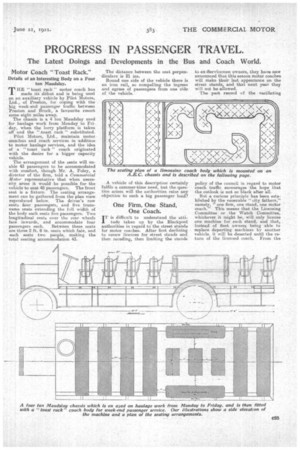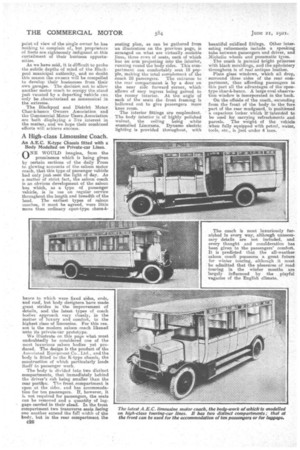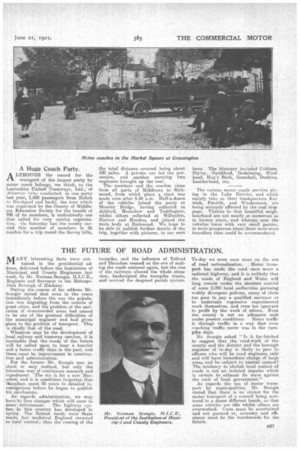PROGRESS IN PASSENGER TRAVEL. The Latest Doings and Developments in the Bus and Coach World.
Page 23

Page 24

Page 25

If you've noticed an error in this article please click here to report it so we can fix it.
Motor Coach "Toast 'Rack,"
Details of an Interesting Body on a Four ton Maudslay.
rrHE "toast rack" motor coach has made ifs debut and is being used on an auxiliary vehicle by Pilot Motors, Ltd., of Preston, for coping with the big week-end passenger traffic between -Preston and Brock, a favourite resort some eight miles away.
The chassis is a 4 ton Maudslay used for haulage work from Monday to Friday, when the lorry platform is taken off and the " toast rack " substituted.
Pilot Motors, Ltd., maintain motor omnibus and coach services in addition to motor haulage services, and the idea of a " toast rack " coach originated with the desire for a bigger capacity vehicle.
The arrangement of the seats will enable 43 passengers to he accommodated with comfort, though Mr. A. Foley, a director of the firm, told a Commercial Motor representative that when necessity arose it would he possible forthe vehicle to seat 48 passengers. The front seat is a fixture. The seating arrangement can be gathered from the plan view reproduced below. The driver's row seats four passengers, and five transverse seats extending the full width of the body each seats five passengers. Two longitudinal seats over the rear wheels face inwards, and accommodate four
passengers each. Between these seats are three 2 ft. B in. seats which face, and each seats two people, making the total seating accommodation 4,3. The distance between the seat perpendiculars is 21 ins.
Round one side of the vehicle there is an iron rail, so compelling the ingress and egress of passengers from one side of the vehicle.
A vehicle of this description certainly fulfils a summer-time need, but the question arises will the authorities raise any objection to such a big passenger loactr
One Firm, One Stand, One Coach.
tr is difficult to understand the atti
tude taken up by the Blackpool authorities in regard to the street stands for motor coaches. After first declining to renew licences for street stands and then receding, then limiting the stands to ex-Servicemen owners, they have now announced that this season motor coaches will make their last appearance on the street stands, and that next year they will not be allowed.
The past record of the vacillating policy of the council in regard to motor coach traffic encourages the hope that the outlook is not so black after all.
But a curious principle has been established by the venerable " city Lathers," namely, "one firm, one stand, one motor coach." This means that the Licensing Committee or the Watch Committee, whichever it might be, will only licenso one machine for eaoh stand, and that, instead of fleet owner* being able to replace departing machines by another vehicle, it will be deserted until the return of the licensed coach. From the
point of view of the single owner he has nothing, to complain of, but proprietors of fleets are righteously indignant at this curtailment of their business opportunities.
As we have said, it is difficult to probe the subtle depths of mind of the Black. pool municipal authority, and no doubt this season the owners will be compelled to develop their businesses from their own garages. • The decision not to allow another motor coach to oectipy the stand just vacated by a departing vehicle can only be characterized as nonsensical in the extreme.
The Blackpool and District Motor, Char-asbencs Owners Association and the Commercial Motor DeeraAsso.ciation are bath displaying a TiVe interest in the matter, and we hope their combined efforts will achieve success.
A High-class Limousine Coach.
An AEC. K-type ehassis fitted with a Body Modelled ,on Private-car Lines.
ONE WOULD imagine, from the prominence which is being given by certain sections of the daily Press to glowing accounts of the saloon motor coach, that this type of passenger vehicle had only just.seen the light of day. As a matter of strict fact, the saloon coach is an obvious development of the saloon bus which, as a type. of passenger vehicle, is in use on regular service throughout the length and breadth of the
land. The earliest types of saloon coaches, it must he agreed, were little more than ordinary open-type chars-it banes to which were fixed sides, ends, and roof, but body designers have made great strides in the improvement of details, and, the latest types of coach bodies approach very closely, in the matter of luxury and comfort, to the highest class of limousine. For this reason is the modern saloon coach likened unto its private-car prototype.
We illustrate on this page what must undoubtedly he considered one of the most !uxurious saloon bodies yet produced. The design is the product of the Associated Egni pment Co., Ltd., and the body is fitted to the K-type chassis, the construction of which particularly lends itself to passenger work.
The body is divided into two distinct compartments, that immediately behind the driver's cab being smaller than the rear porapn. The front .compartment is open at the sides, and has accommodation for ten passengers. If, however, it is not required for passengers, the seats can be removed and a quantity of luggage carried in their stead. In the front compartment two transverse seats facing one another extend the hill width of the body, but in the rear compartment the
626 seating plan, as can be gathered from an illustration on the previous page, is arranged on what are virtually .sociable lines, three rows of seats, each of which has an arm projecting into the interior, running round the body sides. This corn. partment can comfortably seat 18 people, making the total complement of the ,coach 28 passengers. The 'entrance to the rear compartment is by a door on the near side forward corner, which allows of easy ingress being gained to the roomy interior. At the angle of each of the seats the front framing is hollowed out to give passengers more knee room.
The interior fittings are resplendent. The body interior is of highly polished walnut, the ceiling being white enamelled Lincrusta Dynamo electric lighting is provided throughout, with beautiful oxidized fittings. Other interesting refinements include a speaking tube between passengers and driver, and Michelin wheels and pneumatic tyres.
The coach is painted bright primrose with black mouldings, and the upholstery throughout is of real antique leather.
Plate glass windows, Which all drop,. surround three sides of the rear compartment; thus affording passengers in this part all the advantages of the opentype char-k--basics. A large oval observation -window is incorporated in the back.
On the offside of the coach, extending from the front of the bodyto the fore part of the rear mudguard, is positioned a capacious locker which itintended to be used for carrying refreshments and parcels. The weight of the vehicle when fully equipped with petrol, water, tools, etc., is just under 4 tons.
The coach is most luxuriously furnished in every way, although unnecessary details are not included, and every thought and consideration has been given to the passengers' comfort. It is predicted that the all-weather saloon coach possesses a great future for winter touring, although it must be admitted that the pleasures of road touring in the winter months are largely influenced by the playful vagaries of the English climate.
A Huge Coach Party.
•
ALTHOUGH the record for the transport of the largest party by motor coach belongs, we think, to the Lancashire United Tramways, Ltd., of i Atherton (who conducted, n one party last year, 1,450 passengers from BoRun to RiaLlipool and back), the tour which was organized by the County of Middlesex Education Society for the benefit of 700 of its members, is undoubtedly one that called for very careful organization. On Saturday last the society carried this number of members in 26 coaches for a trip round the Surrey hills,
the total distance covered being about 100 miles. A private ear led the procession, and another carrying tWo engineers brought up the rear, The members and the coaches came from all parts of Middlesex to Richmond, from which place a start was made soon after 9.30 a.m. Half-a.dozen of the vehicles joined the party at Moseley Bridge, having collected at Ashford, Hounslow and Teddington, whilst others collected at Willesden, Harrow and Hendon. and joined the main body at Richmond. We hope to be able to publish further details of the trip, together with pictures, in our next iesue. The itinerary inc hided Cobham, Ripley, Guildford, Godalming, Hindhead, Hog's Back, Gomshall, Docking. Leatherheacl, etc.
The various motor coach services plying in the Lake District, and which mainly take as their headquarters Icewick, Penrith, and Windermere, are being seriously affected by the coal stoppage. Visitors to that eautiful
bourhood are not nearly so numerous as in former years, -and, whereas new the vehicles leav.e with. very small parties, in more prosperous times there were more travellers than could be accommodated.






































